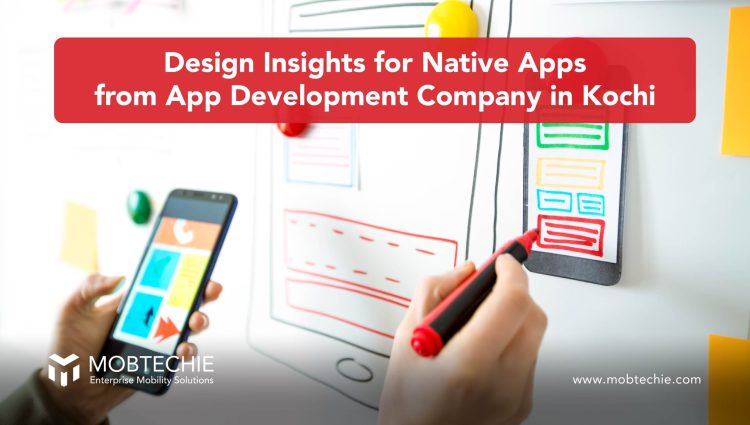Introduction:
Native apps have long been the preferred choice for businesses looking to venture into the mobile app world. As a reputable mobile app development company in Kochi, we understand the importance of designing and developing native apps tailored specifically for iOS and Android platforms.
If you have experienced both iOS and Android phones, you are well aware of the distinct differences between them. As a user, you can notice variations in buttons, tabs, navigation styles, and other controls. While the actions and end goals may be similar, the overall structure and flow differ significantly.
The app market is abuzz with the popularity of both Android and iOS. In this comprehensive guide, we will delve into the design differences between these rival platforms.
Navigation Styles: Differentiating iOS and Android Designs
One of the notable distinctions lies in the navigation styles of iOS and Android. iOS, for instance, lacks a universal navigation bar, which means users cannot utilize it to go back. Instead, iOS incorporates an internal screen back button positioned in the top left corner of the screen, offering an alternative method for navigation.
On the other hand, Android embraces a different approach with its navigation style. It includes a universal navigation bar, enabling users to go back easily. Both platforms also feature left-to-right swipe gestures, but their functionalities differ. While iOS uses this gesture to go back, Android employs it to switch between tabs. As a result, designers must carefully consider these design contradictions to ensure consistency in native app development.
In-App Navigation and Menus: iOS vs. Android Applications
The Human Interface Guidelines by Apple recommend using a bottom tab bar for in-app navigation in iOS. This tab bar acts as a menu, allowing users to swiftly switch between the main sections of a native iOS app. Apple also emphasizes the importance of the bottom tab bar by reserving it for essential options, while relegating lower-level options to the Hamburger menu.
Contrarily, Android favors a menu drawer or navigation drawer for in-app navigation. By opening the drawer, users can access the menu of the app. Material design guidelines also advocate for the inclusion of a bottom navigation bar in Android applications, facilitating user exploration of the primary app content.
Although both platforms incorporate similar elements that serve similar functions, the differences in navigation styles remain prominent design factors for iOS and Android.
Button Designs: iOS vs. Android
Buttons play a crucial role in performing various actions within an app. However, their designs differ between iOS and Android applications. As per Apple’s Human Interface Guidelines, iOS buttons have a flat design without shadows and use Title Case for texts. Additionally, iOS apps may include call-to-action buttons placed at the center of the bottom tab bar to highlight direct actions.
On the other hand, Android employs both flat and raised buttons, as suggested by Material design guidelines. Text on Android buttons is typically in UPPER CASE. Android apps also feature floating buttons for direct actions, such as the “add status” button in WhatsApp. Similarly, call-to-action buttons in iOS and floating buttons in Android signify primary actions in native applications.
Typography: Native iOS and Android Mobile Applications
When it comes to typography, both iOS and Android have their standard system typefaces. Android uses Roboto as its standard system typeface, while iOS utilizes SF Pro (San Francisco). It is crucial to pay close attention to typographical differences when incorporating text into your application to ensure consistency with each platform.
The Appearance of Pickers: iOS vs. Android Applications
Designing elements consistently across iOS and Android platforms can be a challenge, especially when it comes to pickers. Each platform has its unique interaction cases, known as “iOS-like controls” and “Android-like controls.” These controls, such as checkboxes, radio buttons, switches, or toggles, need to be customized to match the design style of iOS or Android.
For example, the date picker varies between the two platforms. Android’s calendar-style picker resembles a physical calendar, where users select a date. In contrast, iOS uses a reel-style date selector, which may be unfamiliar to Android users, and vice versa. Additionally, functions that require selection differ between iOS and Android, with iOS utilizing default toggles and Android employing radio buttons and checkboxes. These features and requirements distinguish the designs of Android and iOS applications.
Naming Conventions: iOS vs. Android Designs
Although naming conventions do not directly relate to design, they have a significant impact on iOS and Android. In fact, certain function names influence design patterns. Let’s explore a few naming conventions specific to each platform.
In iOS, notifications are referred to as “alerts,” while Android uses terms such as “snackbars,” “dialogs,” or “banners” for similar purposes. Android employs snack bars for low-priority alerts that do not require immediate action. Dialogs pause the user interface, prompting users to take action, while banners serve as intermediary elements that encourage specific tasks without interrupting the interface.
These naming conventions directly influence the design patterns in iOS and Android applications. Designers must align visual elements wi犀利士
th the platform-specific naming conventions.
Micro-Interactions: iOS vs. Android Application Designs
As a leading mobile app development company in Kochi, we understand the significance of micro-interactions in enhancing user engagement. Micro-interactions, such as animations and transitions, play a vital role in providing a captivating user experience.
Both iOS and Android platforms encourage subtle micro-interactions that draw users’ attention to essential aspects without overwhelming them. Smooth transitions and well-designed animations contribute to a seamless user experience, guiding users from one screen to another. It is important to adhere to the recommendations outlined in the Human Interface Guidelines and Material Design Guidelines, as users have become accustomed to platform-specific transitions.
In iOS applications, smooth transitions and physics-based scrolling are prevalent throughout the operating system. iOS users are familiar with downward gliding to reveal a view and upward gliding to dismiss it. While such interactions are common among iOS users, they are mainly recommended for highly immersive gaming experiences, as stated by the Human Interface Guidelines.
On the other hand, Android follows the transition patterns defined in Material Design Guidelines. These transitions primarily focus on the navigation aspects of the application. Android incorporates a parent-child element, where an expanding component or interface is the child screen, and the interface from which it expands serves as the parent element. This parent-child relationship facilitates micro-interactions within the app. Additionally, Android features screen sharing within the same parent, where screens transition horizontally, often seen in app store categories, photo albums, or sections of an app.
Conclusion:
As a leading mobile app development company in Kochi, we emphasize the importance of understanding the differences between designing native iOS and Android apps. While there may be exceptions, it is crucial to consider the habits and preferences of users on each platform. By aligning with platform-specific guidelines, incorporating native components, and focusing on micro-animations and micro-interactions, you can create exceptional native apps that deliver an outstanding user experience.
Mobtechie Labs
mobile app development company kochi app development company in kochi android app development company in kochi android app development company cochin






